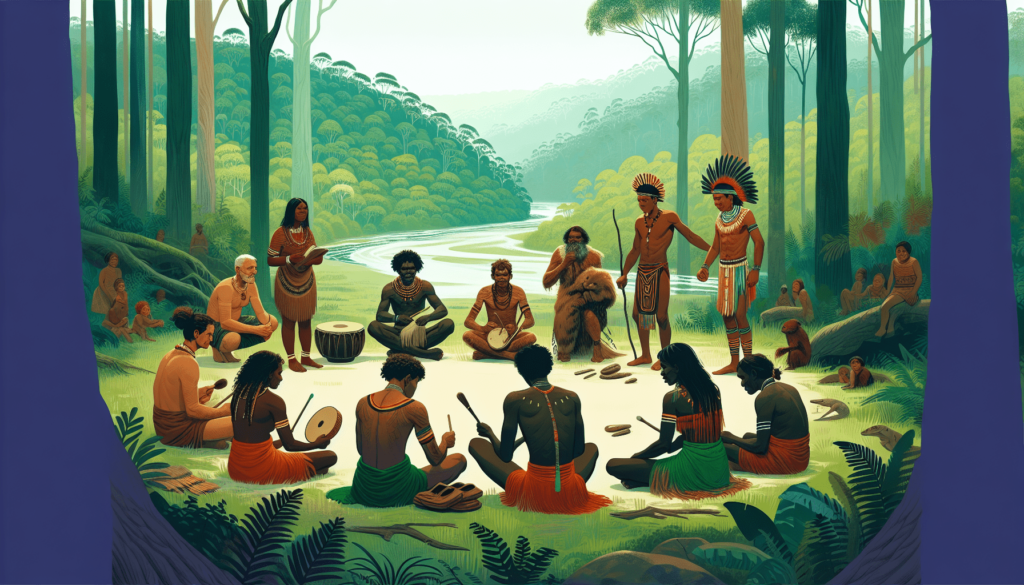If you’ve ever wondered how ancient cultures were able to survive and thrive in the harsh wilderness, then “Ancient Wisdom: Indigenous Survival Secrets For The Modern World” is the article for you. In this captivating read, you’ll uncover the secrets and techniques that have been passed down through generations, allowing indigenous people to conquer nature’s challenges with ease. Whether it’s building a shelter, foraging for food, or navigating treacherous terrains, these ancient wisdoms have stood the test of time and can be applied in today’s modern world. Prepare to be inspired by the resilience and resourcefulness of indigenous communities and learn how to harness their survival secrets for your own adventures.
Introduction
Welcome to “The Survivalist Handbook”! In this article, we will explore the ancient wisdom and indigenous survival secrets that can be applied in the modern world. These time-honored practices have been passed down through generations and can serve as valuable tools for anyone venturing into the wilderness. By understanding and respecting nature, learning traditional medicinal plant uses, tracking and hunting techniques, shelter building, fire making, navigation without technology, and foraging for edible plants, you can enhance your wilderness survival skills and have a truly immersive outdoor experience. So let’s dive in and discover the secrets of indigenous survival!
Understanding Ancient Wisdom
Indigenous cultures have long been in harmony with nature, living off the land and utilizing their deep knowledge of the wilderness. Their survival practices are rooted in an understanding of the interconnectedness of all living things and the importance of maintaining balance in the natural world. By tapping into this ancient wisdom, we can learn valuable lessons about our own relationship with nature and how to navigate the challenges of survival.

Respecting Nature
Before delving into specific survival techniques, it is crucial to emphasize the importance of respecting nature. Indigenous communities have always respected and revered the natural world, recognizing that they are merely a part of the vast ecosystem. By taking the time to observe, listen, and learn from nature, we can develop a deeper appreciation for the environment and minimize our impact on it. This mindset sets the foundation for practicing sustainable survival skills that ensure the preservation and longevity of the wilderness.
1. Traditional Medicinal Plants
One of the most fascinating aspects of indigenous survival is their extensive knowledge of traditional medicinal plants. These plants have been used for centuries to treat a wide range of ailments and injuries. Knowing how to identify and utilize these plants can be a lifesaver in a survival scenario. However, it is crucial to approach the use of such plants with caution, as some may have adverse effects or sustainability concerns.
Uses of Traditional Medicinal Plants
Traditional medicinal plants have a diverse range of applications. They can be used to relieve pain and inflammation, treat wounds and infections, soothe digestive issues, and even support overall wellness. Different cultures have specific plants that are valued for their unique properties, and learning about these plants can provide a deeper understanding of the local environment and its resources.
How to Identify and Use Them
Identifying traditional medicinal plants requires knowledge of their physical characteristics and habitat. Field guides, workshops, or local experts can be valuable resources in learning how to identify these plants. Once identified, understanding the correct preparation and administration methods is essential. Some plants may require drying, grinding, or brewing to release their medicinal properties. It is crucial to respect the dosage and follow instructions carefully to avoid negative side effects.
Sustainability Concerns
With the increasing popularity of natural remedies, it is crucial to consider sustainability when using traditional medicinal plants. Some species may already be endangered due to overharvesting, and indiscriminate collection can further stress the population. Understanding sustainable harvesting practices, such as only taking what is needed and allowing plants to regenerate, is vital to ensure the longevity of these valuable resources.

2. Tracking and Hunting Techniques
Tracking and hunting are ancient survival skills that have enabled indigenous communities to secure food and resources for thousands of years. By honing these skills, we can not only provide for our sustenance but also deepen our connection with the natural world.
Tracking Skills and Techniques
Tracking involves keen observation and interpretation of signs left by animals in their environment. By studying tracks, scat, scratches on trees, and other indicators, you can gain insights into an animal’s behavior, size, and direction of travel. Tracking is an art that requires patience, knowledge of animal habitats, and an understanding of the ecosystem.
Effective Hunting Methods
Once you have honed your tracking skills, it is essential to learn effective hunting methods. Different environments call for different techniques, such as stalking, trapping, or using decoys. Understanding the behavior and habits of the target animal is crucial for a successful hunt. Indigenous communities often employ sustainable hunting practices, such as selective harvesting or using every part of the animal to minimize waste.
Responsible Hunting Practices
Responsible hunting goes beyond simply acquiring food. It entails respecting the animal and its role in the ecosystem. Indigenous communities have long understood the importance of sustainable practices, ensuring that hunting does not disrupt the balance of nature. By following their lead, we can minimize the impact on wildlife populations and contribute to the preservation of the natural environment.
3. Shelter Building
Having a shelter in the wilderness is crucial for protection against the elements and providing a sense of security. Indigenous communities have developed various types of shelters suited to different environments, and their building techniques can teach us valuable lessons in survival.
Types of Shelters Used by Indigenous Communities
Indigenous communities have crafted shelters from natural materials found in their surroundings, such as branches, leaves, and animal hides. These shelters come in many forms, including lean-tos, wigwams, igloos, and tipis. Each type of shelter is tailored to the specific needs dictated by the environment, climate, and availability of resources.
Building Techniques for Different Environments
Building a shelter in the wilderness requires adaptability and resourcefulness. Indigenous survival techniques offer valuable insights into constructing sturdy and weather-resistant shelters. By learning these techniques, you can create effective shelters in diverse terrains, whether it’s a snow-covered landscape, a dense forest, or a scorching desert.
Using Natural Materials
Indigenous communities have always relied on the resources available in their surroundings. By using natural materials to build shelters, they not only minimize their impact on the environment but also create structures that seamlessly blend with the landscape. Learning how to select and utilize these materials can not only enhance your survival skills but also deepen your connection with nature.
4. Fire Making
Fire has been a cornerstone of human survival for millennia. By mastering ancient fire-making methods, understanding fire safety, and utilizing fire for cooking and warmth, you can harness the power of this elemental force in the wilderness.
Ancient Fire-Making Methods
Indigenous cultures have developed ingenious methods for starting fires without modern tools. These methods include friction-based techniques like the bow drill, hand drill, and fire plow. By learning and practicing these ancient techniques, you can rely on them when matches or lighters are not available.
Understanding Fire Safety
While fire is a powerful tool, it must be handled with caution and respect. Understanding fire safety is essential to prevent wildfires and ensure personal safety. Indigenous communities have long understood the importance of fire management, establishing boundaries, and maintaining control over fires. By following their lead, we can ensure that fire remains a helpful ally and not a destructive force.
Using Fire for Cooking and Warmth
Fire serves multiple purposes in the wilderness, providing warmth, a means to cook food, and even purify water. Indigenous survival techniques can teach us how to utilize fire effectively for cooking and warmth while minimizing its environmental impact. Learning about different cooking methods, such as using hot rocks or crafting improvised cooking utensils, can enhance your wilderness dining experience.
5. Navigation without Technology
Navigating without technology may seem intimidating in our GPS-dependent world. However, indigenous communities have honed their navigation skills through observation and a deep understanding of the natural world. By learning to read natural navigational cues, interpreting the stars and celestial bodies, and employing methods for finding direction, you can navigate with confidence in any wilderness setting.
Using Natural Navigational Cues
Nature provides a wealth of navigational cues that can help you find your way in the wilderness. Paying attention to the direction of sunlight, the growth patterns of trees, the behavior of animals, and the flow of water can give you valuable information about your surroundings and guide your path.
Reading the Stars and Celestial Bodies
Stars have guided travelers for centuries, and indigenous communities have developed intricate knowledge of the night sky. By learning to identify constellations, tracking the movement of stars, and understanding celestial navigation, you can find your bearings even on the darkest nights.
Methods for Finding Direction
Indigenous survival techniques offer various methods to determine direction without relying on technology. From using a compass made from natural materials to reading patterns in the growth of moss on trees, these techniques can help you stay on course even when modern navigation tools are unavailable.
6. Edible Plants and Foraging
Foraging for edible plants is a valuable skill that allows you to find sustenance in the wilderness. Indigenous cultures have amassed a wealth of knowledge about identifying edible plants, gathering and preparing them safely, and avoiding poisonous plants. By learning from their traditional practices, you can expand your menu and enhance your survival capabilities.
Identifying Edible Plants in the Wild
Indigenous communities possess a profound understanding of the plants in their environment, knowing which ones are safe to consume and which should be avoided. Learning to identify edible plants requires studying their physical attributes, growth patterns, and habitats. Field guides, mentorship from experienced foragers, or participation in workshops can help you gain this knowledge.
Gathering and Preparing Foraged Food
Once you have identified edible plants, knowing how to gather and prepare them is essential for safe consumption. Indigenous cultures have developed techniques to harvest and process wild food, such as removing toxins, cooking, or drying. Learning these methods can broaden your culinary options and provide sustenance in a survival situation.
Avoiding Poisonous Plants
While foraging for edible plants, it is equally important to recognize and avoid poisonous plants. Indigenous survival techniques emphasize the importance of caution and deep knowledge of the local plant life. Understanding the physical characteristics and warning signs of poisonous plants can help you avoid any potential dangers.
Conclusion
By exploring the ancient wisdom of indigenous communities, we can gain a deeper understanding of survival in the wilderness. Whether it’s harnessing the power of traditional medicinal plants, honing tracking and hunting skills, building shelters, creating fire, navigating without technology, or foraging for edible plants, these practices offer valuable insights for modern-day adventurers. Remember, survival is not just about skill but also about respect for nature and the delicate balance of the ecosystem. By adopting these indigenous survival secrets, we can forge a better connection with the natural world and thrive in any wilderness environment. So go out there, learn, and embrace the wisdom of our ancestors!

